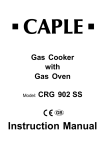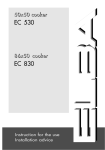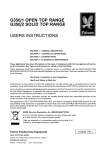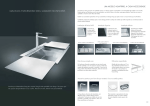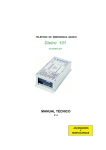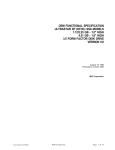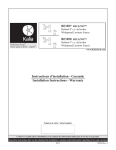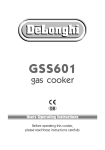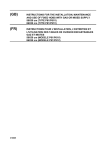Download Elba EC 530 Specifications
Transcript
50x50 cookers EC 530 EC 560 86x50 cookers EC EC EC EC EC EC EC EC 830 832 860 861 862 960 961 930 Instruction for the use Installation advice Dear Customer, We thank you very much for choosing our products. The instructions and advice included in this booklet are given to safeguard your safety and to use this appliance correctly. Be so kind as to keep this booklet. It will be useful to clear any doubt concerning its operation. This appliance must be only assigned to the use for which it has been realized, that is for cooking food. Any other use has to be considered incorrect and therefore dangerous. The manufacturer declines any liability for damages caused by wrong, incorrect or irrational use of the appliance. IMPORTANT INSTRUCTIONS AND ADVICE FOR THE USE OF ELECTRICAL APPLIANCES The use of any electrical appliance requires the compliance with some basic rules, namely: – do not touch the appliance with wet or damp hands (or feet) – do not use the appliance bare feet – do not allow the appliace to be operated by children or disabled without overseeing. The manufacturer cannot be deemed responsible for damages caused by wrong or incorrect use. USEFUL HINTS After removing the appliance from its packing, make sure of its integrity. In case of doubt, please apply to your supplier or to a qualified engineer. The packing materials (plastic bags, polyfoam, nails, metal strips etc.) must be moved away from the reach of the children as potential sources of danger. FIRST USE THE OVEN It is advised to follow these instructions: – Clean the interior of the oven with cloth soaked in water and detergent (neutral), then dry carefully. – Insert shelves and tray. – Switch on the empty oven on max to eliminate grease tracks from the heating elements. 2 – Do not attempt to alter the technical features of the appliance as this may result very dangerous. – Do not carry out any operation of cleaning or maintenance without prior disconnection of the appliance from the electric supply. – Whenever you decide to get rid of this appliance (in case of replacement with a new one), before scrapping it is recommended to render it inoperative and harmless in respect of health and antipollution regulations. 1 - COOKING HOBS GAS COOKING HOBS 2 (Fig. 1.1- 1.2 - 1.3) 1 GENEREAL FEATURES: 1. 2. 3. 4. 5. 3 Auxiliary burner (A) - 900 W Semi-rapid burner (SR) - 1550 W Rapid burner (R) - 2550 W Double-ring burner (DR) - 3500 W Electrical plate Ø 180 - 1500 W 4 Fig. 1.1 2 1 3 4 Fig. 1.2 2 1 5 3 4 Fig. 1.3 3 2 - CONTROL PANEL Fig. 2.1 5 1 2 3 4 9 Fig. 2.2 10-11 6 5 1 2 1 3 4 Fig. 2.3 2 3 4 9 Fig. 2.4 6 10-11 1 2 7 3 4 8 9 Fig. 2.5 6 10-11 1 2 3 4 8 9 CONTROLS DESCRIPTION 4 1. 2. 3. 4. 5. 6. 7. Rear left burner control knob Front left burner control knob Front right burner control knob Rear right burner control knob Gas oven control knob Electrical oven control knob Electrical plate control knob (*) 8. 60' Timer control knob (*) 9. Gas burner electronic igniter control button (*) 10. Oven light control button (*) 11. Rotisserie control button (*) (*): According to the models 3 - USE OF THE HOB BURNERS Each burner is controlled by a gas tap assuring the opening and the closing of the gas supply. Make the indicator of the knob the symbols printed on the control panel: - symbol ● : off - symbol : full on (nominal rate) - symbol : reduced rate To open the tap, which allows the flow of gas to the burner, push the knob and turn it towards the left. To turn it off, turn the knob towards the right up the safety click. The full-on rate serves to bring foods to a boil, while the reduced rate consents the slow heating of foods or the maintenance of the boiling. All of the positions of the different operations must be chosen between the maximum and the minimun and never between the maximum and the turn off point. In the event of the burner flames being accidentally extinguished, turn off the burner control and do not attempt to re-ignite the burner for at least 1 min. SAFETY VALVES Some models are equipped with flamefailure device taps/thermostat. This device allows to stop the gas input to the tap/thermostat whenever the flame goes out. The tap/thermostat opening has to be done as follows: 1) Turn the knob to full-on setting. 2) Light the gas and keep the knob pressed in order to allow the flame to heat the feeler wich activates the magnet controlling the gas input. 3) After few seconds (20 max) leave the knob. Be careful that the feeler be always clean as the dirt may act as thermic insulator. LIGHTING OF TOP BURNERS The cooker has an automatic ignition device. It is enough to push the knob and turn the tap on the “full-on” position (fig. 3.3) until the burner lights, then adjust the flame. In case of electric ignition, push the knob and turn the tap on the “full-on” position. Then push the switch-button (fig. 3.2) until the burner lights. Fig. 3.2 Fig. 3.1 Fig. 3.3 5 MODELS WITH BATTERY IGNITION - If the electronic ignition does not work make sure that the battery, installed on the back of the cooker, is not flat and has been installed correctly (see the chapter “Battery installation”, page 19). CHOICE OF THE BURNER CORRECT USE OF DOUBLE-RING BURNER The flat-bottomed pans are to be placed directly onto the pan-support. To use the WOK you need to place the proper stand in order to avoid any faulty operation of the double-ring burner (Fig. 3.5) On the control panel, near every knob, there is a diagram that indicates which burner is controlled by that knob. The suitable burner must be chosen according to the diameter and the capacity used. As an indication, the burners and the pots must be used in the following way: BURNERS Auxiliary POT DIAMETER 12 - 16 cm Semi-rapid 16 - 20 cm Rapid 20 - 24 cm Double-ring WRONG wok It is important that the diameter of the pot be suitable to the potentiality of the burner so as not to compromise the high output of the burners and therefore energy waste. A small pot on a large burner does not give you a boiling point in a shorten amount of time since the capacity of heat absorption of a liquid mass depends on the volume and the surface of the pot. Fig. 3.5a CORRECT 6 Fig. 3.4 Fig. 3.5b HOTPLATES CORRECT USE OF THE ELECTRICAL PLATES NORMAL HOTPLATES In using the hotplates you must: To switch on the normal hotplate, turn the knob (Fig. 3.6) onto the desired position; the numbers 1 to 6 indicate the working positions with the increase of temperature according to the number. Once boiling point has been reached, reduce the input according to the heating intensity desired, keeping in mind that the plate will continue to heat for 5 minutes after having been turned off. – avoid idle operation (without pots) – do your best not to pour liquids on the plates when they are hot – only use flat bottom pots – always use pots that completely cover the surface of the plate. A lamp signals that the hotplates are operating. RAPID HOTPLATES (red dot) The control knob of the rapid hotplates is similar to that of a normal plate with 6 working positions (Fig. 3.6). The features of this plate, which is equipped with a heat limiter, allow: – reaching the temperature rapidly – maximum exploitation of the input with flat bottom pots – the limitation of input in the case of unsuitable pots. 2 5 1 6 0 3 4 Fig. 3.6 Fig. 3.7 7 NORMAL AND RAPID PLATES Position of switch TYPE OF COOKING 0 Switched OFF 1 2 For melting operations (butter, chocolate). 2 To maintain food hot and to heat small quantities of liquid (sauces, eggs). 3 To heat bigger quantities; to whip creams and sauces. (vegetables, fruits, soups). 4 3 4 Slow boiling, i.e.: boiled meats, spaghetti, soups, continuations of steam cooking of roasts, stews, potatoes. 5 4 For every kind of frying, cutlets, uncovered cooking, i.e.: risotto. 6 4 5 Browning of meats, roasted potatoes, fried fish, omelettes, and for boiling large quantities of water. 6 Fast frying, grilled steaks, etc. 1 2 3 Heating Cooking Roasting-frying 8 Fig. 3.8 4 - GAS OVEN The glass of the oven door reaches high temperatures during operation. Keep children away. For child safety, a door guard can be fitted to prevent contact with the hot glass. The door guard is supplied as an accessory on request. Contact our Service Centre and indicate the relevant appliance model. GENERAL FEATURES The oven is furnished completely clean; it is advisable, however, upon first use, to turn the oven on to the maximum temperature (position 10) for about 15 minutes to eliminate possible traces of grease from the oven burner. The same operation should be followed for grill burner. The gas oven, according to the model, is provided with one or two burners: a) Oven burner, mounted on the lower part of the oven (wattage: 3200 W) OVEN GAS BURNER The gas delivery to the oven burner is controlled a thermostatic tap. LIGHTING OF THE OVEN BURNER 1) Approach a flame to opening “A” fig. 4.2 2) Press thoroughly the knob and turn it anti-clockwise position (fig. 4.1); the indicator should match with the number 10. 3) Wait about ten seconds after the burner lighting before releasing the knob (time of priming of the valve). Close the oven door slowly. 4) Adjust the burner according to the power required. Should the flame of the burner estinguish for any reason, the safety valve will cut off automatically the gas flow to the thermostat. To re-start operation, take the knob to “off” position and repeat operations 1-23 as above explained. b) Grill burner, mounted on the upper part of the oven (wattage: 2000 W). A Fig. 4.1 Fig. 4.2 9 OVEN BURNER THERMOSTAT The numbers 1 to 10 (fig. 4.3) indicate the increasing oven temperature value (see table 4.4). To regulate the temperature, set the knob indicator onto the chosen number. OVEN COOKING To cook, before introducing the food, pre-heat the oven to the desired temperature for the period of time indicated on the table to left (table 4.4). These preheating times indicate the time that a cold and empty oven takes to reach that temperature. When the oven has reached the temperature, introduce the food, control the check the cooking time and turn off the oven 5 minutes before the theoretical time to recuperate the stored heat. Table 4.4 For orientative purposes only, some oven cooking indications are shown on the following table: THERMOSTAT POSITION 0 DISHES 1 Heating of foods 1 Meringue - Fruit pies Cooked fruit 1 Cakes - Amaretti, Vegetables 2-3 Lasagna - Cakes 3-4 Roast veal - Pie crusts 5-6 Wild game - Birds Small fish - Roast pork 6-7 Large fish Roast beef 7-8 Pizza - Red meats 8-9 Toasted sandwiches 2 1-2 3 0 1 4 5 6 7 8 9 Fig. 4.3 10 10 Oven cleaning GRILL BURNER USE OF THE GRILL This burner makes the stainless steel wire net red hot, which, generating infra red rays, permits grilling. Very important: the grill must always be used with the oven door slightly open (Fig. 4.7). Mount shield “A” which serves to protect the control panel from the heat. Turn on the grill, as explained in the preceding paragraphs and let the oven preheat for about 5 minutes with the door slightly open. Introduce the food to be cooked, positioning the rack as close to the grill as possible. To turn on the grill burner: 1) Press thoroughly and turn clockwise the oven gas thermostat knob to set symbol . 2) Put a flame to the right and left side of the burner for 2-3 seconds after the thermostat has been opened (fig. 4.6). 3) Wait about ten seconds after the burner lighting before releasing the knob (time of priming of the valve). Should the flame of the burner estinguish for any reason, the safety valve will cut off automatically the gas flow to the tap. To re-start operation, take the knob to “off” position and repeat operations 1-2-3 as above explained. ROTISSERIE Except for some models, the ovens are equipped with a rotisserie for cooking on the spit using the grill (fig. 4.9). This device is made up of: – an electrical motor mounted on the rear part of the oven – a stainless steel rod, equipped with a detachable athermic grip and 2 recordable forks – a rod support to be inserted into the central rack holders of the oven. The rotisserie motor is operated by the switch indicated by the symbol on the control panel (fig. 4.9). Fig. 4.5 A Fig. 4.6 Fig. 4.7 11 12 USE OF THE ROTISSERIE OVEN LIGHT Very important: the rotisserie must always be used with the oven door slightly open and with shield "A” mounted (Fig. 4.7). – Insert the dripping pan into the lowest rack holders of the oven and insert the rod support into the intermediate rack holders. – Put the meat to be cooked onto the rod, being careful to secure it in the center with the special forks. – Insert the rod into the motor opening and rest it onto the support of the spit collar; then remove the grip by turning it to the left. The rotation direction of the rotisserie can be either clockwise or counter-clockwise. Except for some models, the oven is equipped with a light that illuminates the oven to enable visually controlling the food that is cooking. This light is controlled by a switch on the control panel (fig. 4.9). Fig. 4.8 Fig. 4.9 5 - ELECTRICAL CONVECTION OVEN The glass of the oven door reaches high temperatures during operation. Keep children away. For child safety, a door guard can be fitted to prevent contact with the hot glass. The door guard is supplied as an accessory on request. Contact one of our dealers or Service Centre and indicate the relevant appliance model. GENERAL FEATURES The oven is furnished completely clean; it is advisable, however, upon first use, to turn the oven on to the maximum temperature (pos. 10 = 240°C) for about 15 minutes to eliminate possible traces of grease on the heating elements. The convection oven is eqipped with 3 electrical heating elements: – 2 elements (upper and lower) for normal oven cooking – 1 grill element, on the top of the oven, for grilling which must be done with the oven door slightly open and with the protection shield for the control panel mounted. 0 The input of the element is: – upper element, 960 W – lower element, 1340 W – grill element, 1900 W ELECTRICAL THERMOSTAT Turn on the oven or grill elements by turning the switch that is also provided with a thermostat to control the oven temperature. To regulate the temperature or function, turn the control knob until the required number or symbol is level with the vertical line on the control panel. The switch/thermostat symbols indicate: – Position “0”= off – Position from “1 to 10” = simultaneous operation of the 2 elements. The numbers correspond to the temperature shown in the table 5.2. The elements will turn on and off automatically depending on the temperature required commanded by the thermostat. – Position = lower element only in operation without temperature control. – Position = upper element only in operation without temperature control. 3 2 1 – Position 0 4 1 = grill element in operation without temperature control (see specific paragraph). The automatic turning on and off of the elements is signalled by a light above the knob. 9 8 5 7 6 Fig. 5.1 13 OVEN LIGHT The oven is equipped with a light that illuminates the oven to enable visually controlling the food that is cooking. This light is controlled by a switch on the control panel (fig. 5.3). For orientative purposes only, some oven cooking indications are shown on the following table: OVEN COOKING THERMOSTAT POSITION DISHES To cook, before introducing the food, preheat the oven to the desired temperature for the amount of time indicated in table 5.2. 1-4 Heating of foods 4-5 Meringue - Fruit pies Cooked fruit The preheating times shown indicate the time that a cold and empty oven takes to reach that temperature. 5-6 Cakes - Amaretti, Vegetables 6 Lasagna - Cakes When the oven has reached the desired temperature, introduce the food, control the cooking time and turn off the oven 5 minutes before the theoretical time to recuperate the stored heat. 6-7 Roast veal - Pie crusts 8 Wild game - Birds Small fish - Roast pork 9 Large fish Roast beef 9 - 10 Pizza - Red meats 10 Toasted sandwiches 10 Oven cleaning ELECTRICAL GRILL 14 Fig. 5.3 The grill element has got 1900 W input and is controlled by the switch/thermostat by positioning the knob onto the relevant symbol . A ROTISSERIE Except for some models, the ovens are equipped with a rotisserie for cooking on the spit using the grill. This device is made up of: – an electrical motor mounted on the rear part of the oven – a stainless steel rod, equipped with a detachable athermic grip and 2 recordable forks – a rod support to be inserted into the central rack holders of the oven. The rotisserie motor is operated by the switch indicated by the symbol on the control panel (fig. 5.2). Fig. 5.4 USE OF THE ROTISSERIE Fig. 5.5 USE OF THE GRILL Very important: the grill must always be used with the oven door slightly open (Fig. 5.4). Very important: the rotisserie must always be used with the oven door slightly open and with shield "A” mounted (Fig. 5.4). – Insert the dripping pan into the lowest rack holders of the oven and insert the rod support into the intermediate rack holders. – Put the meat to be cooked onto the rod, being careful to secure it in the center with the special forks. – Insert the rod into the motor opening and rest it onto the support of the spit collar; then remove the grip by turning it to the left. The rotation direction of the rotisserie can be either clockwise or counter-clockwise. The oven door becomes very hot during operation. Keep children away. Mount shield “A” which permits to protect the control panel from the heat. Turn on the grill, as explained in the preceding paragraphs and let the oven preheat for about 5 minutes with the door slightly open. Introduce the food to be cooked, positioning the rack as close to the grill as possible. 15 6 - TIMER MECHANICAL TIMER The timer is equipped with a time buzzer and may be regulated for a maximum period of 60 minutes. The regulating knob (fig. 6.1) must be turned in a clockwise direction until it reaches the 60 minutes position and then turned to the desired time by turning the knob in a counterclockwise direction. 1 0 0 5 2 0 0 4 30 Fig. 6.1 16 7 - GENERAL ADVICE * When the appliance is not being used, it is advisable to keep the gas tap closed. From time to time check to make sure that the flexible tube that connects the gas line or the gas cylinder to the appliance is in perfect condition and eventually substitute it, if it shows signs of wearing or damage. * The periodical lubrification of the gas taps must be done only by specialized personnel. In case of difficulty in the gas taps operation, call Service. GLASS LID Do not lower the glass lid when burners or electric plates are still hot or when the oven is working or still hot. Do not lay on the glass lid hot pans and heavy kitchen utensils. CAUTION: glass lids may shatter when heated. Turn off all the burners before shutting the lid. For cleaning purposes, the lid can be easily removed upwards once taken to the upright position. Should the hinges slip off, replace them in their housing being careful that: – The right housing must receive the hinge marked “D” while the left housing must receive the hinge marked “S” (Fig. 7.1). Attention: The cooktop becomes very hot while in operation. The oven door becomes very hot during operation. Keep children away. REGULATING OF THE BALANCE Lower the lid and check the correct balance. While opened at 45° it should hang up. If necessary, register the calibration of the hinge springs using the screws “R” (fig. 7.1). R D S Fig. 7.1 17 8 - CLEANING AND MAINTENANCE Always switch the cooker off at the mains isolating switch before cleaning or touching any electrical part. GENERAL ADVICE It is advisable to clean when the appliance is cold and especially for cleaning the enamelled parts. Avoid leaving alcaline or acidic substances (lemon juice, vinegar, etc.) on the surfaces. Avoid using cleaning products with a chlorine or acidic base. ENAMELLED PARTS All of the enamelled parts must be washed only with a sponge and soapy water or with non-abrasive products. Dry, preferably, with deer skin. HOT PLATE Foods burned on the hot plates must always be cleaned dry. Do not use water to avoid the forming of rust. Be careful with the central feeler of the automatic plates, it must never be shined and must only be cleaned with a damp cloth. After its use, pour a bit of oil onto the warm plate and rub with a cloth. OVEN The oven must always be cleaned after every use, using suitable products and keeping in mind that its operation for 30 minutes on the highest temperature eliminates most grime reducing it to ashes. The clean-up of the oven with catalytic self-cleaning enamel is done automatically during cooking, and therefore no intervention is necessary. Only when the grime is particularly resistant it is advisable to increase the cleaning time leaving the electrical elements on at the maximun temperature, with the oven empty. It is mandatory not to use abrasive substances so as not to damage the self-cleaning coating. OVEN DOOR The oven door is cleaned in the same way that is advisable for the enamelled surfaces. The internal glass of the oven door can be easily removed for cleaning by unscrewing the two lateral fixing screws (fig. 8.1). BURNERS, GRATES AND RACKS These parts may be removed and washed with suitable products. The burners and their caps must be well dried after cleaning and put back perfectly into their slots. It is very important to verify the positioning of the burner-caps because a misplacing in their slots can cause serious damage. In the appliances with electrical ignition for the burners, verify that the electrode is always cleaned well as to permit the regular snap of the spark. 18 Fig. 8.1 SUBSTITUTION OF THE OVEN LAMP Before replacing the oven lamp, make sure to disconnect the appliance mains. The light bulb must be a type resistant to high temperatures (300° C). 6 - BATTERY INSTALLATION BATTERY INSTALLATION Models with battery ignition INSTALLING THE BATTERY Insert a type C battery (1.5 Volt) into the battery compartment on the back of the cooker (fig. 8.2). This battery is the power supply for the electronic ignition of gas burners. Batteries last on average for about two years (alkaline battery) depending on how often the electronic ignition is used. Notes for battery installation or replacement: Fig.8.2 - Only use a type C 1.5 Volt battery. - Check for correct polarity (fig. 8.3 and label to the side of the battery compartment). Important notes: 1,5 V Fig.8.3 - Remove the battery if the cooker is not going to be used for a long time. - If the battery leaks, replace it immediately. Avoid touching the leaked liquid and make sure it does not come into contact with clothes or other items. - Clean the battery compartment carefully before installing the new one. - Note: The battery is a potential source of danger for children. Keep them away. - Dispose of flat batteries properly. 19 Advice for the installer LOCATION The cooker has “type X” or “Class 1”overheating protection so that it can be installed next to a cabinet whose height is greater than that of the cooker. 500 mm 800 mm It is advisable that the kitchen furniture near the sides of the cooker is made of heat resistant material, minimum 75 °K. 500 mm m 20 m m 20 m 20 Fig. 8.4a 500 mm 800 mm 500 mm GAS OVEN Class 1 20 mm Fig. 8.4b 500 mm 800 mm 20 mm 500 mm IC ELECTR OVEN Type X Fig. 8.4c 21 CHOOSING SUITABLE SURROUNDINGS Extractor hood for products of combustion In the room chosen to accommodate the gas appliance, there must be an adequate natural draft to allow combustion of the gas. The natural draft must be produced directly by one or more vents made in the external walls and providing a total opening of at least 100 cm2. The vents must be positioned close to the floor, preferably on the opposite side to the combustion discharge outlet and must be designed in such a way that they cannot be obstructed either from the inside or the outside. Air vent Fig. 8.5 When it is not possible to provide the necessary vents, the draft may be supplied from an adjacent room, ventilated in the required manner, provided it is not a bedroom or an area at risk. In this event, the door of the kitchen must be opened to allow the draft to enter the room. DISCHARGING PRODUCTS OF COMBUSTION Electric fan to extract products of combustion A 22 Fig. 8.6 Extractor hoods connected directly to the outside must be provided, to allow the products of combustion of the gas appliance to be discharged (fig. 8.5). If this is not possible, an electric fan may be used, attached to the external wall or the window; the fan should have a capacity to circulate air at an hourly rate of 3-5 times the total volume of the kitchen (fig. 8.6). The fan can only be installed if the room has suitable vents to allow air to enter, as described under the heading “Choosing suitable surroundings”. 11 - GAS SECTION The walls adjacent to the oven must be of material resistant to heat. GASES The gases used for the operation of cooking appliances may be grouped by their characteristics into two types: – L.P.G. (in cylinders) – NATURAL GAS – TOWN GAS INSTALLATION The appliance is predisposed and adjusted to operate with the gas indicated on the specifications plate applied onto the appliance. Plug If the appliance must be operated with a gas different than that indicated on the plate, it is necessary to execute the following operations: 1) Gas connection 2) Replacement of the top injectors 3) Regulating of the primary air of the top burners 4) Adjustment of the minimum of the top 5) Replacement of the injector of oven burner 6) Replacement of the injector of grill burner 7) Primary air of oven burner 8) Primary air of grill burner 9) Adjustment of the oven burner minimum Plug Fig. 11.1 23 These operations must be carefully fulfilled as follows. 1 - GAS CONNECTION – Connect the cooker to the gas mains utilizing rigid or flexible pipes. – The connection must be executed to the rear of appliance (fig. 11.1); the pipe do not cross the cooker. – The unused end inlet pipe of the cooker (left or right) must be closed with the plug interposing the gasket. L.P.G. (G30/G31) – If not mounted, fit up the holder “R” to the holder “M” interposing gasket “Q”. – Connect the cooker to the cylinder pressure regulator by a suitable rubber tube (inside diameter 8 mm). Natural gas (G20) or Town Gas (G110) – Remove the holder “R”. – Connect the cooker to the gas net by a suitable rubber tube (inside diameter 13 mm). The rubber tube must be as short as possible, without contractions or kinks. Gas connection for: IMPORTANT: The fitting (fig. 11.2) is made up of: After connecting to the mains, check that the couplings are correctly sealed, using soapy solution, but never a naked flame. – 1 adapter “M” for Natural Gas (G20) or Town Gas (G110) – 1 adapter “R” for L.P.G. (G30/G31) – gasket “D” and “Q” D M Q R 24 Fig. 11.2 GAS CYLINDER CONNECTION The connection between the hose connector on the cooker and the regulator of the gas cylinder must be made using a 60 cm long flexible hose conforming to applicable standards, and hose clamps. The connection hose must be inserted in the hose support (fig. 11.4) and pushed over the hose connectors to the full depth. Hose clamp IMPORTANT: Only max 13 kg cylinders may be used in the cylinder compartment, and they must be positioned in such a way that the regulator and shut-off cock are easily accessible. When changing the gas cylinder, do not withdraw the hose from the hose support G. Installation and replacement of gas cylinders must only be carried out by qualified persons. Pressure regulator Plug G Hose support Hose length: 60 cm Gas cylinder: 13 kg maximum Hose clamp Fig. 11.4 25 2 - INJECTORS REPLACEMENT OF TOP BURNERS To replace the injectors, raise the cooktop in the following manner (fig. 11.5): – Litf the cooking top (fig. 11.5) – Fully raise the adjusting air tube A (fig. 14.4) in order to easily reach the injector. – Loose the screw “M” of each injector and fully raise the adjusting air tube “A” (fig. 11.6). – By a polygonal 7 spanner, remove the injector “J” from their housing and replace it by the proper one according to the kind of gas (see injectors table). 3 - ADJUSTMENT OF PRIMARY AIR OF TOP BURNERS By operating on the screw “M”, reset the air adjuster “A” according to the instructions indicated on the table for the choice of the injectors, where the distance between injector and air adjuster is recommended (in mm). Before lowering the cooktop, set the burners on their sites and light them in order to check whether the flames are correct, as per the specifications given in the next page. In case of uncorrect flame, lift or lower the air adjuster. Flame faulty in primary air Flame correct Flame with excess primary air long, vellow and trembling clear interior blue cone short and sharp too blue interior cone tending to detach CAUSE air regulating tube, too closed correct distance of the tube air regulating tube, too open M A 26 Fig. 11.5 Fig. 11.6 J 4 - ADJUSTMENT OF THE MINIMUN OF THE TOP BURNERS Considering that in the minimum position the flame must have a length of about 4 mm and must remain lit even with a brusque passage from the maximum position to that of minimum. The flame adjustment is done in the following way: – Turn on the burner – Tum the tap to the MINIMUM position – Take off the knob – With a small flat screwdriver turn the screw inside the tap rod to the correct regulation (fig. 11.7). In the taps with safety valves tur the screw F (fig. 11.8). Normally for G30/G31 gas, tighten up the regulation screw. F Fig. 11.7 Fig. 11.8 27 TABLE FOR THE CHOICE OF THE INJECTORS INCREASE OF AIR NECESSARY FOR GAS COMBUSTION (2 m3/h kW) Air necessary for combustion [m3/h] 1,80 3,10 6,10 5,10 6,40 4,00 BRULEURS Auxiliary (A) Semi-rapid (SR) Rapid burner (R1) Rapid burner (R2) Thermostat oven Grill TABLE FOR THE CHOICE OF THE INJECTORS G 30 – 30 mbar (L.P.G.) BURNERS type 28 Rating Reduced Watt power [W] 300 G 20 – 20 mbar (NATURAL GAS) G 110 – 8 mbar (TOWN GAS) Ø mm injector mm ring opening Ø mm injector mm ring opening Ø mm injector mm ring opening 0.47 3 0.70 1.5 1.30 1 A 900 SR 1550 380 0.62 5.7 0.88 2 1.70 1,5 R 2550 500 0.78 6.5 1.15 2 2.20 1,5 DR 3500 850 0.92 Fully open 1.35 5 2.80 5 OVEN 3200 850 0.86 Fully open 1.30 5 2.70 5 GRILL 2000 – 0.72 Fully open 1.05 9 2.15 9 5 - REPLACEMENT OF THE OVEN BURNER INJECTOR 6 - REPLACEMENT OF THE GRILL BURNER INJECTORS According to the type of gas, the oven injectors are to be similarly replaced, as stated on the table of the paragraph 2, operating as follows: – remove the oven bottom – unscrew the burner fixing screw (Fig. 11.9) – slip the burner itself from the oven (Fig. 11.10) – remove the injector from the connection and replace it with the proper one – remove the grill burner by unscrewing the front screws (fig. 14.8) – substitute the injector (fig. 14.9) with a number 7 tubular spanner – re-mount the burner. Fig. 11.11 Fig. 11.9 Fig. 11.10 Fig. 11.12 29 7 - PRIMARY AIR OF THE OVEN BURNER 8 - PRIMARY AIR OF THE GRILL BURNER With a screwdriver untighten the two screws (fig. 14.10 and move forward or backward to close or open the air flow, the air ring according to the Air Adjustment Table. Light the burner and check the flames. With a screwdriver untighten the screw (fig. 14.11) and turn the air ring to close or open the air flow, according to the Air Adjustment Table. Light the burner and check the flames. Fig. 11.14 Ring opening (see “Injector Table” on page 25) Fig. 11.13 Ring opening (see “Injector Table” on page 25) 30 9) REGULATING OF THE OVEN MINIMUM To be effected only for the oven burner (as the grill burner has an only fixed input) operating on the thermostat as follows: – Light the oven taking the knob to position 10 (max) – remove the knob and by a thin screwdriver (3 mm section - 100 mm long) unscrew of about a half turn the bypass, passing through the front panel hole (see picture below) – fit the knob and let the oven heat for 10 minutes, then take the knob to position 1 allowing the thermostat to work under by-pass G (fig. 9.11). – after further removal of the knob, stop slowly the screw by-pass (being careful not to turn the knob) until the flame reaches 3-4 mm high. N.B. For LPG the by-pass screw must be fixed thoroughly. LUBRIFICATION OF THE GAS TAPS If the gas tap becomes stiff, it is necessary to dismount it accurately clean it with gasoline and spread a bit of special grease resistant to high temperatures on it. The operations to be executed are as follows: – Turn off the valve of the gas supply or of the cylinder. – Remove the control panel as indicated in previous paragraphs. – Unscrew the two screws that block the coupling flange. – Remove the coupling flange and the spring of the knob holder rod. – Lift the gas regulation cone. – Accurately clean it with gasoline. – Accurately spread it with a bit of grease suitable for high temperatures being careful not to obstruct the holes for the gas passage. – Re-mount all of the pieces, verifying that the spring and the rotation pin of the cone mounted on the knob holder rod are perfectly in place. G Fig. 9.11 31 12 - ELECTRICAL SECTION IMPORTANT: The cooker must be installed in accordance with the manufacturer’s instructions. Incorrect installation, for which the manufacturer accepts no responsibility, may cause damage to persons, animals and things. GENERAL – The cooker is supplied without a power supply plug and therefore if you are not connecting directly to the mains, a standardized plug suitable for the load must be fitted. – If the power supply cable is damaged it must be substituted by a suitable cable available in the after sales service. N.B. For connection to the mains, do not use adapters, reducers or branching devices as they can cause overheating and burning. If the installation requires alterations to the domestic electrical system or if the socket and appliance plug are incompatible, call an expert. He should also check that the socket cable section is suitable for the power absorbed by the appliance. – Connection to the mains must be carried out by qualified personnel in accordance with current regulations. – The appliance must be connected to the mains checking that the voltage corresponds to the value given in the rating plate and that the electrical cable sections can withstand the load specified on the plate. – The plug must be connected to an earthed socket in compliance with safety standards. – If the cooker is to be connected directly to the mains, it must be placed with an omnipolar switch with minimum opening between the contacts of 3 mm between the appliance and the mains. – The power supply cable must not touch the hot parts and must be positioned so that it does not exceed 75°C at any point. – Once the cooker has been installed, the switch or socket must always be accessible. 32 ELECTRICAL FEEDER CABLE The cooker is predisposed to operate in alternated mono-phase voltage of 230 V - 50 Hz. To operate the appliance just plug in the plug, equipped with a grounding connection, which bears the maximum power indicated on the specification plate on the appliance. WARNING This appliance must be earthed CONNECTING FEEDER CABLE To connect the feeder cable to the cooker it is necessary to: Before effecting any intervention on the electrical parts of the appliance, the connection to the network must be interrupted. – Remove the screw that hold shield “A” behind the oven (fig. 12.1). – Insert the feeder cable of the suitable section (see Feeder Cable Section) into the cable clamp “D”. – Connect the phase cables to terminal “B”. – Pull the feeder cable and block it with cable clamp “D”. – Re-mount shield “A”. E FEEDER CABLE SPECIFICATIONS TYPE HO5RR-F D Cookers without heating elements/plates: 230 V 3 x 0,75 mm2 Cookers with electric oven: 230 V 3 x 1,5 mm2 B Cookers with 1 electric plate and electric oven: 230 V 3 x 2,5 mm2 Fig. 12.1 A 33 REPAIRS Before effecting any intervention on the electrical parts of the appliance, the connection to the network must be interrupted. REMPLACEMENT OF ELECTRICAL COMPONENTS SITUATED UNDER THE COOKTOP Switches and thermostats, igniter and electrodes can be replaced after lifting the cooktop, following the instructions shown in the chapter “REPLACEMENT OF THE INJECTORS OF THE TOP BURNERS”. REPLACEMENTOF THE OVEN AND GRILL ELEMENTS The substitution of the electrical elements of the oven and the grill is done in the following way: – Dismount the back panel of the apliance – Unhook the electrical connections of the broken elements – Unscrew the screws that fasten the element – Remove the element from the inside of the muffle. For the lower element lift the bottom entrance of the oven – Effect the substitution – Re-mount, being particularly careful of the grounder of all of the electrical components. 3 4 1 2 4 P2 N P1 P 3 1 2 5 34 Fig. 12.4 P3 Identification label 35 Descriptions and illustrations in this booklet are given as simply indicative. The manufacturer reserves the right, considering the characteristics of the models described here, at any time and without notice, to make eventual necessary modifications for their construction or for commercial needs. Cod. 1102515 - ß2




































